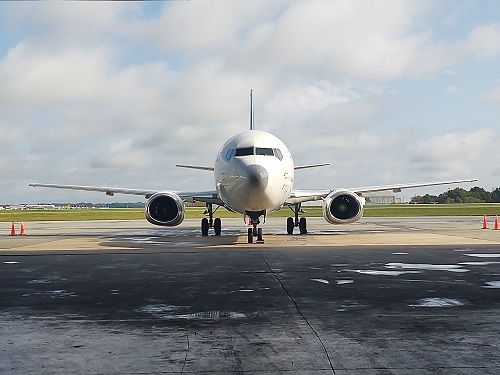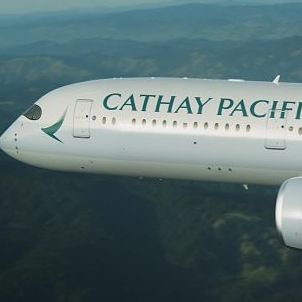Moderators: richierich, ua900, PanAm_DC10, hOMSaR
a question for airline mechanics who are familiar with aircraft repair history
When i was growing up, my dad worked in the airline industry. I can only remember, as a passenger, that mechanical problems were not very frequent. So in that group would be the 707 and variants, DC8 and variants, DC9, etc.
I understand that the population has increased, with many more flights and ever growing technology. Does the large amount of computer based parts on aircraft of today, lead to “technical “ mechanicals as well? For current mechanicals, what percentage of problems are tech related?
Going back to the 70s and 80s, there were no technical developments around to assist . I also am guessing that a 707 engine was easier to repair than an A320? I am not knowledgeable at all in this area, and my assumptions might be incorrect. I would enjoy reading your thoughts. Thank you
I understand that the population has increased, with many more flights and ever growing technology. Does the large amount of computer based parts on aircraft of today, lead to “technical “ mechanicals as well? For current mechanicals, what percentage of problems are tech related?
Going back to the 70s and 80s, there were no technical developments around to assist . I also am guessing that a 707 engine was easier to repair than an A320? I am not knowledgeable at all in this area, and my assumptions might be incorrect. I would enjoy reading your thoughts. Thank you
-

- SteelChair
- Posts: 2674
- Joined:
Re: a question for airline mechanics who are familiar with aircraft repair history
I think you are making great leaps of logic that don't necessarily connect.
Today's airplanes are utilizing more and more airplane health monitoring. A crude example: how long it takes a pneumatic valve to open. If it is taking longer and longer, or longer than average, they'll have mechanics check it out on an overnight. Many problems have been fixed this way in the last 5 years, BEFORE they actually stopped working altogether.
At the same time, some problems are generated by tech. Trying to get a computerized airplane up and running for first flight of the day in the winter for example.
Engines easier or harder to repair differs greatly depending upon what is wrong. Computers do help with quicker diagnosis most of the time.
Today's airplanes are utilizing more and more airplane health monitoring. A crude example: how long it takes a pneumatic valve to open. If it is taking longer and longer, or longer than average, they'll have mechanics check it out on an overnight. Many problems have been fixed this way in the last 5 years, BEFORE they actually stopped working altogether.
At the same time, some problems are generated by tech. Trying to get a computerized airplane up and running for first flight of the day in the winter for example.
Engines easier or harder to repair differs greatly depending upon what is wrong. Computers do help with quicker diagnosis most of the time.
Re: a question for airline mechanics who are familiar with aircraft repair history
Thank you. When you start from scratch on a subject completely unfamiliar to someone it’s understandable, at least to me, that “logic” comes after you learn about something.
Re: a question for airline mechanics who are familiar with aircraft repair history
About 99% of the problems I run into are solved by doing the CTRL-ALT-DEL to the component that is generating the ECAM caution.
Pull circuit breaker X99. wait 10 seconds, push circuit breaker X99, wait for component to reinitialize, ECAM goes away.
Continue flight.
Pull circuit breaker X99. wait 10 seconds, push circuit breaker X99, wait for component to reinitialize, ECAM goes away.
Continue flight.
Re: a question for airline mechanics who are familiar with aircraft repair history
ozark1 wrote:When i was growing up, my dad worked in the airline industry. I can only remember, as a passenger, that mechanical problems were not very frequent. So in that group would be the 707 and variants, DC8 and variants, DC9, etc.
I understand that the population has increased, with many more flights and ever growing technology. Does the large amount of computer based parts on aircraft of today, lead to “technical “ mechanicals as well? For current mechanicals, what percentage of problems are tech related?
Going back to the 70s and 80s, there were no technical developments around to assist . I also am guessing that a 707 engine was easier to repair than an A320? I am not knowledgeable at all in this area, and my assumptions might be incorrect. I would enjoy reading your thoughts. Thank you

The 757/767 and A320 were introduced in the 80's, and were the first to introduce the computer-assisted fault monitor systems you are referring to.
-

- Starlionblue
- Posts: 21730
- Joined:
Re: a question for airline mechanics who are familiar with aircraft repair history
Woodreau wrote:About 99% of the problems I run into are solved by doing the CTRL-ALT-DEL to the component that is generating the ECAM caution.
Pull circuit breaker X99. wait 10 seconds, push circuit breaker X99, wait for component to reinitialize, ECAM goes away.
Continue flight.
This. So much this. You get an ECAM in flight going to an outport. The next day you ask the engineer what actually happened.
"We checked everything. Could not find anything. Did reset and BITE test. All good to go now."
-

- ReverseFlow
- Posts: 899
- Joined:
Re: a question for airline mechanics who are familiar with aircraft repair history
Resetting things in flight reminds me of this
https://www.baaa-acro.com/crash/crash-a ... 162-killed
The 380 and 350 partially have SSPCs you can't reset in flight.
But the software reset breakers/switches are still on the overhead panel.
https://www.baaa-acro.com/crash/crash-a ... 162-killed
The 380 and 350 partially have SSPCs you can't reset in flight.
But the software reset breakers/switches are still on the overhead panel.
-

- Starlionblue
- Posts: 21730
- Joined:
Re: a question for airline mechanics who are familiar with aircraft repair history
ReverseFlow wrote:Resetting things in flight reminds me of this
https://www.baaa-acro.com/crash/crash-a ... 162-killed
The 380 and 350 partially have SSPCs you can't reset in flight.
But the software reset breakers/switches are still on the overhead panel.
Indeed, but, as evidenced by this crash, you're not supposed to pull them willy-nilly. First, consult the QRH. Check carefully. The flight computers can also be reset in flight, in the same fashion.
Nitpick but they're not breakers. They're switches.
-

- ReverseFlow
- Posts: 899
- Joined:
Re: a question for airline mechanics who are familiar with aircraft repair history
Starlionblue wrote:ReverseFlow wrote:Resetting things in flight reminds me of this
https://www.baaa-acro.com/crash/crash-a ... 162-killed
The 380 and 350 partially have SSPCs you can't reset in flight.
But the software reset breakers/switches are still on the overhead panel.
Indeed, but, as evidenced by this crash, you're not supposed to pull them willy-nilly. First, consult the QRH. Check carefully. The flight computers can also be reset in flight, in the same fashion.
Nitpick but they're not breakers. They're switches.
I know they are not breakers - they don't have a current rating on them

But they look like the breakers, so people tend to forget that they reset the software and don't cut power.
-

- Strebav8or
- Posts: 215
- Joined:
Re: a question for airline mechanics who are familiar with aircraft repair history
I'll jump in on this, too.
The control computers (black boxes) on the aircraft have more and more redundant channels. These computers cross-talk to each other, along with having a modeling channel, in some instancees, that tell the computer how it should act/function. I will say that these improvements show wear and tear happening over time, versus the old "Fly to Failure" aspect.
Additionally, I do not believe that we have more failures today because of flight frequency. Truth be told, we are actually flying safer. The reason that we see more faults is much beter health monitoring of the aircraft systems with better and more accurate picture of what is wrong from the health monitoring. One final take on this is that the rise of the interwebs sites and social media that report more on aircraft that divert and have delays.
The control computers (black boxes) on the aircraft have more and more redundant channels. These computers cross-talk to each other, along with having a modeling channel, in some instancees, that tell the computer how it should act/function. I will say that these improvements show wear and tear happening over time, versus the old "Fly to Failure" aspect.
Additionally, I do not believe that we have more failures today because of flight frequency. Truth be told, we are actually flying safer. The reason that we see more faults is much beter health monitoring of the aircraft systems with better and more accurate picture of what is wrong from the health monitoring. One final take on this is that the rise of the interwebs sites and social media that report more on aircraft that divert and have delays.
Re: a question for airline mechanics who are familiar with aircraft repair history
Starlionblue wrote:Woodreau wrote:About 99% of the problems I run into are solved by doing the CTRL-ALT-DEL to the component that is generating the ECAM caution.
Pull circuit breaker X99. wait 10 seconds, push circuit breaker X99, wait for component to reinitialize, ECAM goes away.
Continue flight.
This. So much this. You get an ECAM in flight going to an outport. The next day you ask the engineer what actually happened.
"We checked everything. Could not find anything. Did reset and BITE test. All good to go now."
Starlionblue wrote:Woodreau wrote:About 99% of the problems I run into are solved by doing the CTRL-ALT-DEL to the component that is generating the ECAM caution.
Pull circuit breaker X99. wait 10 seconds, push circuit breaker X99, wait for component to reinitialize, ECAM goes away.
Continue flight.
This. So much this. You get an ECAM in flight going to an outport. The next day you ask the engineer what actually happened.
"We checked everything. Could not find anything. Did reset and BITE test. All good to go now."
This is the probably most common fix I see and use. Reset and everything checks out and usually it doesn’t repeat. And when it doesn’t fix the issue the advances in technology usually make troubleshooting much easier compared to earlier planes. Modern planes will tell you what’s wrong, or stuff from the 80s on will at least give you a fault code to get you started. And the advances in technology makes applying MEL’s to dispatch the plane easier in a lot of cases. Just apply a sticker instead having to deactivate a mechanical system.
As far as ease of maintenance, I haven’t worked either airframes or engines mentioned in the original post, but in general, newer generations of planes at least considered maintenance when designing. I’m general, newer aircraft are easier to work on in my opinion. There’s always things that are hard to get to and that varies depending on the task. I think technology has increased reliability greatly, not the other way around.
-

- ReverseFlow
- Posts: 899
- Joined:
Re: a question for airline mechanics who are familiar with aircraft repair history
acmx wrote:Like you say nowadays you have more advanced troubleshooting (than previously) with predictive maintenance etcStarlionblue wrote:Woodreau wrote:About 99% of the problems I run into are solved by doing the CTRL-ALT-DEL to the component that is generating the ECAM caution.
Pull circuit breaker X99. wait 10 seconds, push circuit breaker X99, wait for component to reinitialize, ECAM goes away.
Continue flight.
This. So much this. You get an ECAM in flight going to an outport. The next day you ask the engineer what actually happened.
"We checked everything. Could not find anything. Did reset and BITE test. All good to go now."Starlionblue wrote:Woodreau wrote:About 99% of the problems I run into are solved by doing the CTRL-ALT-DEL to the component that is generating the ECAM caution.
Pull circuit breaker X99. wait 10 seconds, push circuit breaker X99, wait for component to reinitialize, ECAM goes away.
Continue flight.
This. So much this. You get an ECAM in flight going to an outport. The next day you ask the engineer what actually happened.
"We checked everything. Could not find anything. Did reset and BITE test. All good to go now."
This is the probably most common fix I see and use. Reset and everything checks out and usually it doesn’t repeat. And when it doesn’t fix the issue the advances in technology usually make troubleshooting much easier compared to earlier planes. Modern planes will tell you what’s wrong, or stuff from the 80s on will at least give you a fault code to get you started. And the advances in technology makes applying MEL’s to dispatch the plane easier in a lot of cases. Just apply a sticker instead having to deactivate a mechanical system.
As far as ease of maintenance, I haven’t worked either airframes or engines mentioned in the original post, but in general, newer generations of planes at least considered maintenance when designing. I’m general, newer aircraft are easier to work on in my opinion. There’s always things that are hard to get to and that varies depending on the task. I think technology has increased reliability greatly, not the other way around.
That's why engine manufacturers can offer power-by-the-hour, as their algorithms will predict if the engines will fail and they get maintenance done or replace them at a convenient time before a failure occurs and the aircraft has to be grounded.
I also found this bit from pages 24, 30 and 36 regarding troubleshooting from Qantas/Airbus.
https://aircraft.airbus.com/sites/g/fil ... ST58_0.pdf
Apparently an A320 has about 13000 parameters fed into the DMU/FDIMU (this is CEO from 2002 - the NEO probably has a bit more).
[ https://www.cockpitseeker.com/wp-conten ... toring.pdf
Page 59]
An A350 or A380 has much higher order of magnitude than that even, so you'll know the state of most (all?) electric/electronic equipment on board.
And if you're lucky, that is recorded somewhere after the event

Re: a question for airline mechanics who are familiar with aircraft repair history
Something else to consider is how many more maintenance stations that there were in the 60s and 70s which were a result of the complex prop liners of the 1950s. TWA had maintenance in small stations such as Louisville, Cincinnati and Indianapolis while Delta (Western) staffed mechanics in tiny Kalispell Montana. Most of these maintenance stations started disappearing in the early 80s-mid 90s.
Re: a question for airline mechanics who are familiar with aircraft repair history
Strebav8or wrote:I'll jump in on this, too.
The control computers (black boxes) on the aircraft have more and more redundant channels. These computers cross-talk to each other, along with having a modeling channel, in some instancees, that tell the computer how it should act/function. I will say that these improvements show wear and tear happening over time, versus the old "Fly to Failure" aspect.
Additionally, I do not believe that we have more failures today because of flight frequency. Truth be told, we are actually flying safer. The reason that we see more faults is much beter health monitoring of the aircraft systems with better and more accurate picture of what is wrong from the health monitoring. One final take on this is that the rise of the interwebs sites and social media that report more on aircraft that divert and have delays.
Current tech is no longer to have black boxes, on the A350 for example what was an individual LRU on earlier types is now a software application hosted on what is essentially an industrial blade server with a real time operating system. They have multiple servers for redundancy.
Troubleshooting and testing is done in software, using testers is unusual.
The aircraft generates GBs of data each flight which is offloaded by Wi-Fi/gsm once on the ground.
-

- Strebav8or
- Posts: 215
- Joined:
Re: a question for airline mechanics who are familiar with aircraft repair history
zeke wrote:Strebav8or wrote:I'll jump in on this, too.
The control computers (black boxes) on the aircraft have more and more redundant channels. These computers cross-talk to each other, along with having a modeling channel, in some instancees, that tell the computer how it should act/function. I will say that these improvements show wear and tear happening over time, versus the old "Fly to Failure" aspect.
Additionally, I do not believe that we have more failures today because of flight frequency. Truth be told, we are actually flying safer. The reason that we see more faults is much beter health monitoring of the aircraft systems with better and more accurate picture of what is wrong from the health monitoring. One final take on this is that the rise of the interwebs sites and social media that report more on aircraft that divert and have delays.
Current tech is no longer to have black boxes, on the A350 for example what was an individual LRU on earlier types is now a software application hosted on what is essentially an industrial blade server with a real time operating system. They have multiple servers for redundancy.
Troubleshooting and testing is done in software, using testers is unusual.
The aircraft generates GBs of data each flight which is offloaded by Wi-Fi/gsm once on the ground.
I use the term "black boxes" as a familiarity term.
I am very versed in the use of Centers and Cards to replace the boxes, which performt he same functions on newer aircraft (A350, E-170/-175/-190/-195, for example)
Who is online
Users browsing this forum: AECM and 39 guests

